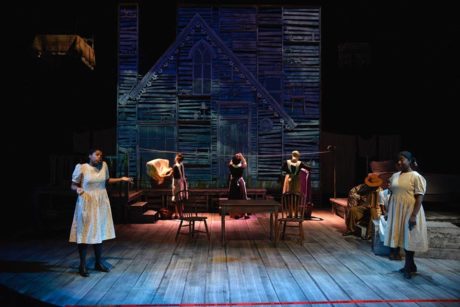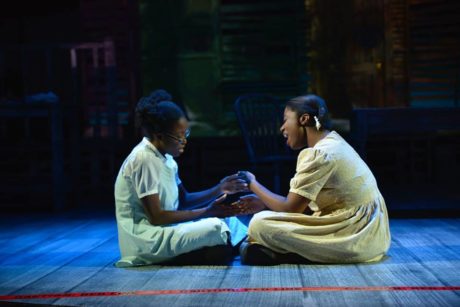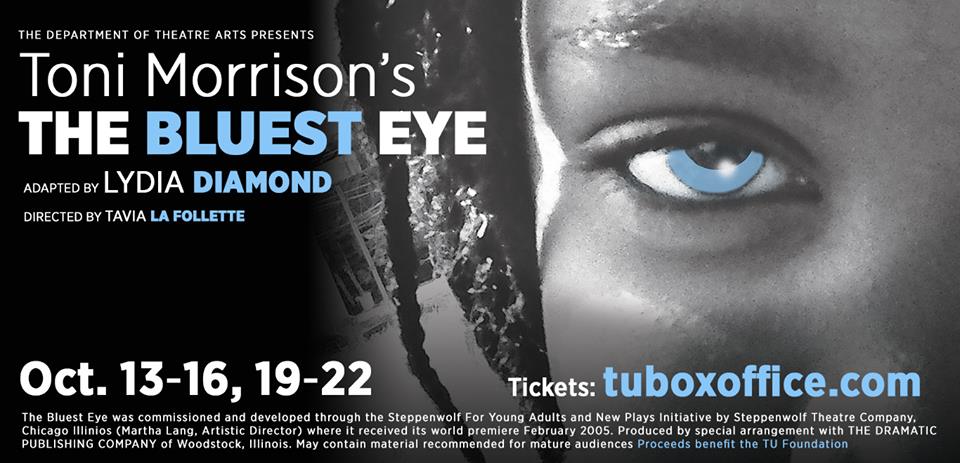‘The Bluest Eye’ is a moving tale about race, dysfunction, and poverty
Director Tavia La Follette, a Towson University professor, in choosing The Bluest Eye to direct, chose to examine how children see a society marred by racism, colorism, alcoholism, and poverty. Based on a novel by the renowned, Pulitzer and Nobel award-winning novelist Toni Morrison, the show was adapted in 2005 by Huntington Playwriting Fellow Lydia R. Diamond via Steppenwolf’s Young Adult & New Plays Initiative. The Bluest Eye is a triumphant – yet somber – study of family dysfunction and race, as it relates to self-image.

The story is about nine-year-old Claudia (Tamara James) and her sister, ten-year-old Frieda MacTeer (the impressive Catherine Ejiogu), who live in Lorain, Ohio with their parents, near the end of the Great Depression. The proverbial apple cart is upset by a boarder the MacTeers take in (after a house fire displaces her), a young girl named Pecola (the wonderful Lashea Johnson).
Pecola has been tortured by life—nearly everyone thinks she is undesirable and ugly; and from that life, Pecola escapes into a fantasy world, based in Hollywood, and worships Hollywood star Shirley Temple and reads Dick and Jane books. In a 21st Century society in which a Black doctor can barely convince bystanders to a medical emergency that she is indeed a doctor, Pecola is an example of Black female societal invisibility. As La Follette put it:
“The hope is—that through acknowledging and claiming responsibility for the past—we can alter the repetition of it. Sadly, not much has changed and this story is as relevant today as it was in the 1940s.”
If I am going to talk about characters in the show, I must talk about the set, which was practically the 14th actor in the show—it was gorgeous. Designed primarily by Scenic Designer Daniel Ettinger, it consisted of aged, grayish wooden planks, which made up a front façade of an old house; many props, including everything from guitars to toys, and a bed and a children’s table-and-chair set that were flown (i.e. suspended from the rafters); it was an attention grabber that drew the audience into this 1940s world. What was the symbolic meaning of the flown set pieces? A family or childhood in limbo? La Follette makes her audience think of the possibilities.
Working in tandem with Ettinger’s brilliant set, was Jay Herzog’s amazing lighting design, which did everything from set the mood and time of day via use of the upstage scrim, to depicting off-screen White characters by use of silhouetting actors from behind a window. There was also extensive use of projecting film footage on the house—footage of everything from contemporary scenes of civil unrest and films. Scene and lighting design helped create a memorable world for the cast to play in.
The show started with a spoken-word song created by the excellent Jared Swain, who played the tragic character Cholly. “Hear her, Kill for her, Be real to her, (Black women)” the lyrics went, as sang by Swain, and as Aaron Hancock, who powerfully played town mystic Soaphead Church, kept time by pounding a stick on the stage floor. Later, the cast hummed a haunting chant that was unforgettable.
From there, Mamma (Yakima Rich) and Daddy (Isaiah Harvey) gave their daughters Claudia and Freida a lesson on how to keep their house warm for the winter. Cholly and his wife Mrs. Breedlove were introduced as a once loving couple, who at this point in their marriage have tactically agreed not to kill each other when they fight. Rosey Young, as Mrs. Breedlove, performed a marvelous monologue describing their backstory. Young was Mrs. Breedlove, faults and all. Young’s performance bordered on flawless.
But most of all there was 11-year-old, shy and awkward Pecola, who wanted pretty, blue eyes…pretty blue eyes so she can be treated as well as her White classmates, or at least as well as fair-skinned “high-yellow queen” Maureen Peal (the fantastic Amber Davis), was born with six fingers on each hand that had nubs (The extra fingers were cut off). It was Maureen who was most guilty of colorism, at one point calling Claudia, Freida and Pecola, all darker-skinned than her – ugly.
Claudia took a pro-Black stance to all this, complaining that when she saw Bill “Bojangles” Robinson dance with Shirley Temple on screen in a movie, “It should have been me [dancing], or at least someone who looked like me.” Since she “felt invisible next to White girls”, it was Claudia who wanted to “kill” Pecola’s white doll. As an audience member, James made me see the world through Claudia’s eyes.

Claudia, Freida and Pecola had a memorable scene in which they talked about where babies came from and the process of becoming women. This scene foreshadowed tragic events to come, deep in the second act. Johnson’s Pecola here, and throughout showed a mixture of curiosity and innocence. Johnson’s demeanor and physicality brought 11-year-old Pecola to reality on stage.
Mrs. Breedlove, a maid, exhibited a profound self-hatred in a scene that took place in her employer’s house.When Pecola accidently spilled hot blueberries on the floor it was the daughter of her White employers (Davis), she comforted, not Pecola, who received a harsh slap.
In a scene detailing Cholly’s back story, Cholly and his girl Darlene (Rachel Douglass) are caught on the verge of making love, when a shotgun-toting White man forces them to finish while he watches (again the silhouette was used here). Was it this trauma that damaged Cholly to the point when he commits an unspeakable crime, within his own family, later in life?
I liked the motif of three-women-gossiping\three-women mourning that La Follette used. For those scenes, she used Woman 1, 2 and 3: Yakima Rich, Sydney Pope, and Amber Davis respectively.
Pecola participated in her own rescue when it came to getting her blue eyes; she sought the council of the Rev. Ike-like, faith-healer-mystic Elihue Micah Whitcomb aka Soaphead Church, who turns out to bring more harm to Pecola than good, in fact using her to unwittingly commit a crime that he was too lazy (or cowardly) to do himself. Hancock was spellbinding in his great monologue that highlighted his thinking and his character—and his railing against God.
Bookended within the show is the planting of marigolds by Claudia and Freida, which to them have a symbolic foreshadowing on the life of Pecola. Symbolism ruled the story and the show.
I loved Pecola’s Dick and Jane” book prop (good job, House Properties Supervisor Elizabeth Worhtington and Properties Assistant Laura Gede). The show will leave you thinking about the nature of prejudice and retaining a sense of self through it all. As Dramaturg Melanie Slusar explained: “A classmate of Morrison’s ‘confided to her the same dream of blue eyes’ that was then replicated as Pecola’s ideal sense of self…for thirty years a little black girl was told she was ugly compared to white beauty standards…yet, after seventy years, white beauty standards still reign today.”
Towson University’s powerful The Bluest Eye was well-performed by a spectacular cast. It’s definitely a ‘must see’ for this excellent Fall Theater Season.
Running Time: One hour and 45 minutes, with a 15-minute intermission.
The Bluest Eye plays through Saturday, October 22, 2016 at Mainstage Theatre at Towson University Center for the Arts – 7700 Osler Drive, in Towson, MD. For tickets call (410) 704-3288, or purchase them online.
RATING:





